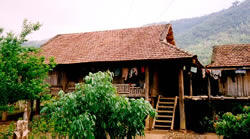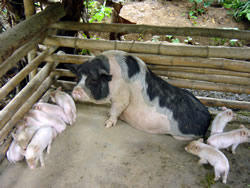- Salud animal
- Nutrición animal
- Genético y biodiversidad
- Medio ambiente y recursos naturales
- Socio-economía en sector del cerdo
- Calidad y seguridad del alimento
- Cría y prácticas sostenibles
- Desarrollo rural
Conservation of autochthonous pig breeds | A model for conservation of autochthonous pig breeds on smallholder farms
To prevent the extinction of local breeds, Vietnam founded the National Programme on Conservation of the Vietnamese Animal Genetic Resources. Under the direction of the National Institute of Animal Husbandry (NIAH), special sub-programmes were founded for the protection and conservation of certain domestic animal breeds...
Problem


Objectives

Data collection

The farmers were interviewed following a questionnaire on:
General results: Small - scale pig production in North Vietnam
Most of the farms visited conducted small-scale pig production with one or two breeding sows and a small number of fattening pigs.

This system requires high input (feedstuff, breeding material, veterinary and extension services, transport, artificial insemination, and hired labour). However, it also yields a high output of pig production and thus high cash-income. The net profit of this production form (difference of output of pig production and variable costs) is high. On the other hand, due to the high costs the economic efficiency (quotient of output of pig production and variable costs) is lower when compared with pig production in the low-input-system. This type of system can also be found at the participants of the I-pig-programme.

Because of the animals low performance the net profit is low (difference of output of pig production and variable costs). However, the variable costs are low, too, because of the utilization of farm-by products as feedstuffs and own breeding material. Therefore average economic efficiency (quotient of output of pig production and variable costs) is higher compared to pig production of the Kinh-farmers.
Special results: I-pig-programme
The participation of farmers in the I-pig-programme is based on a contract between farmer and programme manager, who is employed by NIAH. Central coordination is done by NIAH. Since the foundation of the conservation programme a slight increase in population (size of nucleus) has occurred. On the other hand, inbreeding has also increased.
The farmers mainly produce F1-piglets by artificial insemination of female I-pig with semen of exotic boars that are sold after fattening. Farmers get governmental subsidies for participation in the I-pig-programme and for production of pure I-pigs. Due to these subsidies, they yield a higher income when compared to their situation before. On the other hand, income is still lower than those of small-scale farmers in the neighbourhood using other breeds than I-pig.

Discussion: Conservation of local pig breeds
Nevertheless, extending the conservation efforts to other local breeds makes sense not only with regard to conservation but also with view to the economic situation of the potential participants. The Meo-pig seems to be the most interesting candidate for a “new” conservation programme. The breed is well accepted by farmers and has good economic characteristics.
However, given certain shortfalls of the I-pig-programme, a few changes are suggested:
Comentarios
CIRAD © 2007 (Derechos reservados) - Legales informaciones - Actualizaión de la pagina : 05/06/2007
